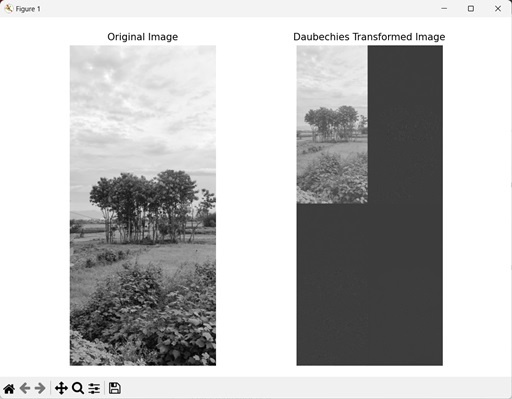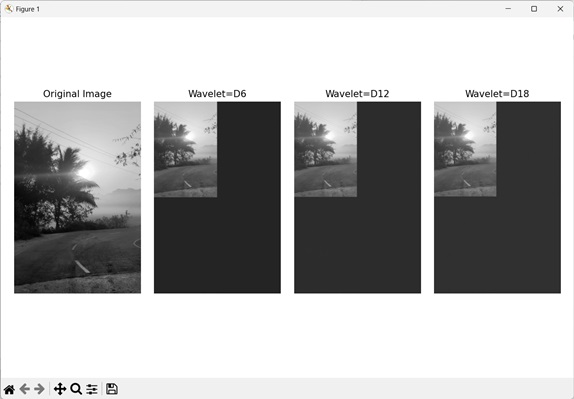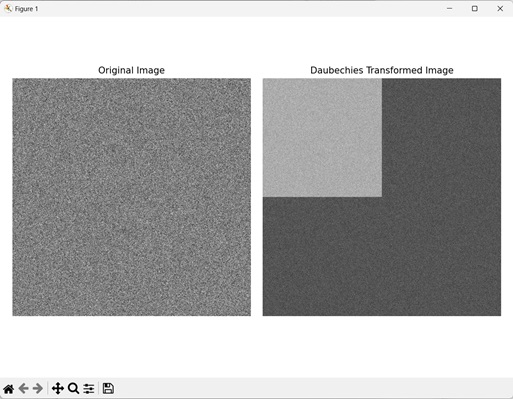
- Mahotas - Home
- Mahotas - Introduction
- Mahotas - Computer Vision
- Mahotas - History
- Mahotas - Features
- Mahotas - Installation
- Mahotas Handling Images
- Mahotas - Handling Images
- Mahotas - Loading an Image
- Mahotas - Loading Image as Grey
- Mahotas - Displaying an Image
- Mahotas - Displaying Shape of an Image
- Mahotas - Saving an Image
- Mahotas - Centre of Mass of an Image
- Mahotas - Convolution of Image
- Mahotas - Creating RGB Image
- Mahotas - Euler Number of an Image
- Mahotas - Fraction of Zeros in an Image
- Mahotas - Getting Image Moments
- Mahotas - Local Maxima in an Image
- Mahotas - Image Ellipse Axes
- Mahotas - Image Stretch RGB
- Mahotas Color-Space Conversion
- Mahotas - Color-Space Conversion
- Mahotas - RGB to Gray Conversion
- Mahotas - RGB to LAB Conversion
- Mahotas - RGB to Sepia
- Mahotas - RGB to XYZ Conversion
- Mahotas - XYZ to LAB Conversion
- Mahotas - XYZ to RGB Conversion
- Mahotas - Increase Gamma Correction
- Mahotas - Stretching Gamma Correction
- Mahotas Labeled Image Functions
- Mahotas - Labeled Image Functions
- Mahotas - Labeling Images
- Mahotas - Filtering Regions
- Mahotas - Border Pixels
- Mahotas - Morphological Operations
- Mahotas - Morphological Operators
- Mahotas - Finding Image Mean
- Mahotas - Cropping an Image
- Mahotas - Eccentricity of an Image
- Mahotas - Overlaying Image
- Mahotas - Roundness of Image
- Mahotas - Resizing an Image
- Mahotas - Histogram of Image
- Mahotas - Dilating an Image
- Mahotas - Eroding Image
- Mahotas - Watershed
- Mahotas - Opening Process on Image
- Mahotas - Closing Process on Image
- Mahotas - Closing Holes in an Image
- Mahotas - Conditional Dilating Image
- Mahotas - Conditional Eroding Image
- Mahotas - Conditional Watershed of Image
- Mahotas - Local Minima in Image
- Mahotas - Regional Maxima of Image
- Mahotas - Regional Minima of Image
- Mahotas - Advanced Concepts
- Mahotas - Image Thresholding
- Mahotas - Setting Threshold
- Mahotas - Soft Threshold
- Mahotas - Bernsen Local Thresholding
- Mahotas - Wavelet Transforms
- Making Image Wavelet Center
- Mahotas - Distance Transform
- Mahotas - Polygon Utilities
- Mahotas - Local Binary Patterns
- Threshold Adjacency Statistics
- Mahotas - Haralic Features
- Weight of Labeled Region
- Mahotas - Zernike Features
- Mahotas - Zernike Moments
- Mahotas - Rank Filter
- Mahotas - 2D Laplacian Filter
- Mahotas - Majority Filter
- Mahotas - Mean Filter
- Mahotas - Median Filter
- Mahotas - Otsu's Method
- Mahotas - Gaussian Filtering
- Mahotas - Hit & Miss Transform
- Mahotas - Labeled Max Array
- Mahotas - Mean Value of Image
- Mahotas - SURF Dense Points
- Mahotas - SURF Integral
- Mahotas - Haar Transform
- Highlighting Image Maxima
- Computing Linear Binary Patterns
- Getting Border of Labels
- Reversing Haar Transform
- Riddler-Calvard Method
- Sizes of Labelled Region
- Mahotas - Template Matching
- Speeded-Up Robust Features
- Removing Bordered Labelled
- Mahotas - Daubechies Wavelet
- Mahotas - Sobel Edge Detection
Mahotas - Daubechies Wavelet
Daubechies wavelets are perpendicular wavelets, which refer to mathematical functions that can represent an image using waves.
Daubechies wavelets have a non−zero value only within a finite interval and are characterized by a maximum number of vanishing moments.
Vanishing moments of a wavelet refers to the number of moments that is equal to zero. Moments are integrals (area under a curve) of the wavelet function multiplied by powers of x.
A wavelet with more vanishing moments better represents smooth signals, while a wavelet with fewer vanishing moments better represents signals with discontinuities.
Daubechies Wavelet in Mahotas
In Mahotas, we can apply Daubechies wavelet transformation on an image using the mahotas.daubechies() function.
It supports multiple Daubechies wavelets ranging from D2 to D20, where the integer represents the number of vanishing moments in a wavelet.
The transformations involve breaking the image into low−frequency (smooth features) and high−frequency coefficients (detailed features). This allows different frequencies of the image to be analyzed independently.
The mahotas.daubechies() function
The mahotas.daubechies() function takes a grayscale image as input, and returns the wavelet coefficients as a new image.
The wavelet coefficients are a tuple of arrays that correspond to the smooth and the detailed features of the image.
Syntax
Following is the basic syntax of the daubechies() function in mahotas −
mahotas.daubechies(f, code, inline=False)
Where,
f − It is the input image.
code − It specifies the type of wavelet to use, can be 'D2', 'D4',....., 'D20'.
inline (optional) − It specifies whether to return a new image or modify input image (default is False).
Example
In the following example, we are applying Daubechies wavelet transformation on an image using the mh.daubechies() function.
import mahotas as mh
import numpy as np
import matplotlib.pyplot as mtplt
# Loading the image
image = mh.imread('nature.jpeg')
# Converting it to grayscale
image = mh.colors.rgb2gray(image)
# Applying Daubechies transformation
daubechies_transform = mh.daubechies(image, 'D20')
# Creating a figure and axes for subplots
fig, axes = mtplt.subplots(1, 2)
# Displaying the original image
axes[0].imshow(image, cmap='gray')
axes[0].set_title('Original Image')
axes[0].set_axis_off()
# Displaying the Daubechies transformed image
axes[1].imshow(daubechies_transform, cmap='gray')
axes[1].set_title('Daubechies Transformed Image')
axes[1].set_axis_off()
# Adjusting spacing between subplots
mtplt.tight_layout()
# Showing the figures
mtplt.show()
Output
Following is the output of the above code −

Multiple Daubechies Wavelets
Another way of applying Daubechies wavelet transformation is by using multiple Daubechies wavelets. Multiple Daubechies wavelets refers to a set of wavelets having different vanishing moments.
In mahotas, to apply multiple Daubechies wavelets we first create a list of different wavelets. Then, we traverse over each wavelet in the list.
Finally, we apply the different wavelets to the input image using the mh.daubechies() function.
For example, lets say we have a list of three wavelets − D6, D12, and D18. The three wavelets will have 6, 12, and 18 vanishing moments respectively.
Hence, three output images will be generated, each having a different Daubechies wavelet applied to it.
Example
In the example mentioned below, we are applying multiple Daubechies wavelets transformations on an image.
import mahotas as mh
import numpy as np
import matplotlib.pyplot as mtplt
# Loading the image
image = mh.imread('sun.png')
# Converting it to grayscale
image = mh.colors.rgb2gray(image)
# Creating list of multiple Daubechies wavelets
daubechies_wavelets = ['D6', 'D12', 'D18']
# Creating subplots to display images for each Daubechies wavelet
fig, axes = mtplt.subplots(1, len(daubechies_wavelets) + 1)
axes[0].imshow(image, cmap='gray')
axes[0].set_title('Original Image')
axes[0].set_axis_off()
# Applying Daubechies transformation for each Daubechies wavelet
for i, daubechies in enumerate(daubechies_wavelets):
daubechies_transform = mh.daubechies(image, daubechies)
axes[i + 1].imshow(daubechies_transform, cmap='gray')
axes[i + 1].set_title(f'Wavelet={daubechies}')
axes[i + 1].set_axis_off()
# Adjusting spacing between subplots
mtplt.tight_layout()
# Showing the figures
mtplt.show()
Output
Output of the above code is as follows −

Daubechies Wavelet on a Random Image
We can also perform Daubechies transformation by using Daubechies wavelets on a random image of two dimension.
A random two−dimensional image refers to an image having a random intensity value for each pixel. The intensity value can range from 0 (black) to 255 (white).
In mahotas, to perform Daubechies wavelet transformation on a random image, we first specify the dimensions (length and width) of the 2−D image.
Then, we pass these dimension along with the intensity range (0 to 255) to np.random.randint() function to create the random image. Since the channel value is not specified, the created image is a grayscale image.
After that, we apply Daubechies wavelet transformation by specifying the wavelet we want to use.
Example
In here, we are applying Daubechies wavelet transformation on a randomly generated two−dimensional image.
import mahotas as mh
import numpy as np
import matplotlib.pyplot as mtplt
# Specifying the dimensions
length, width = 1000, 1000
# Creating a random two-dimensional image
image = np.random.randint(0, 256, (length, width))
# Applying Daubechies transformation
daubechies_transform = mh.daubechies(image, 'D2')
# Creating a figure and axes for subplots
fig, axes = mtplt.subplots(1, 2)
# Displaying the original image
axes[0].imshow(image, cmap='gray')
axes[0].set_title('Original Image')
axes[0].set_axis_off()
# Displaying the Daubechies transformed image
axes[1].imshow(daubechies_transform, cmap='gray')
axes[1].set_title('Daubechies Transformed Image')
axes[1].set_axis_off()
# Adjusting spacing between subplots
mtplt.tight_layout()
# Showing the figures
mtplt.show()
Output
After executing the above code, we get the following output −
